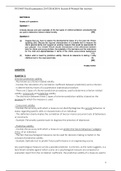Exam (elaborations)
Worked out Answers for Section B of Past PYC4807 Exams!!
- Course
- Institution
- Book
I have worked out thorough answers for ALL Section B questions from past PYC4807 examination papers. These notes will help you to prepare for your exam! These notes include ALL Section B questions and worked out answers of previous exams (2017/2018/2019). Please note these notes do not include Sect...
[Show more]





